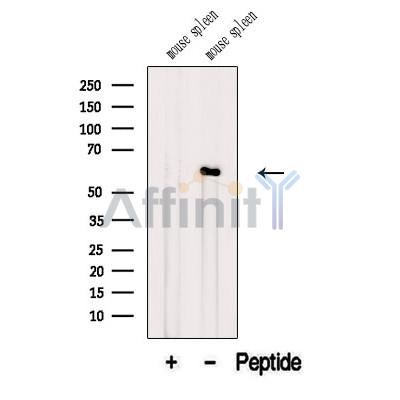ANGPTL2 Antibody - #DF12557
| Product: | ANGPTL2 Antibody |
| Catalog: | DF12557 |
| Description: | Rabbit polyclonal antibody to ANGPTL2 |
| Application: | WB |
| Cited expt.: | WB |
| Reactivity: | Human, Mouse, Rat |
| Prediction: | Pig, Bovine, Horse, Sheep, Rabbit, Dog, Chicken, Xenopus |
| Mol.Wt.: | 57 kDa; 57kD(Calculated). |
| Uniprot: | Q9UKU9 |
| RRID: | AB_2845519 |
Related Downloads
Protocols
Product Info
*The optimal dilutions should be determined by the end user.
*Tips:
WB: For western blot detection of denatured protein samples. IHC: For immunohistochemical detection of paraffin sections (IHC-p) or frozen sections (IHC-f) of tissue samples. IF/ICC: For immunofluorescence detection of cell samples. ELISA(peptide): For ELISA detection of antigenic peptide.
Cite Format: Affinity Biosciences Cat# DF12557, RRID:AB_2845519.
Fold/Unfold
AI593246; Angiopoietin like 2; Angiopoietin related protein 2; Angiopoietin-like protein 2; Angiopoietin-related protein 2; ANGL2_HUMAN; Angptl2; Arp2; AW260363; HARP; MGC8889; UNQ170/PRO196;
Immunogens
A synthesized peptide derived from human ANGPTL2, corresponding to a region within the internal amino acids.
Widely expressed in heart, small intestine, spleen and stomach. Also found in lower levels in colon, ovary, adrenal gland, skeletal muscle and in prostate.
- Q9UKU9 ANGL2_HUMAN:
- Protein BLAST With
- NCBI/
- ExPASy/
- Uniprot
MRPLCVTCWWLGLLAAMGAVAGQEDGFEGTEEGSPREFIYLNRYKRAGESQDKCTYTFIVPQQRVTGAICVNSKEPEVLLENRVHKQELELLNNELLKQKRQIETLQQLVEVDGGIVSEVKLLRKESRNMNSRVTQLYMQLLHEIIRKRDNALELSQLENRILNQTADMLQLASKYKDLEHKYQHLATLAHNQSEIIAQLEEHCQRVPSARPVPQPPPAAPPRVYQPPTYNRIINQISTNEIQSDQNLKVLPPPLPTMPTLTSLPSSTDKPSGPWRDCLQALEDGHDTSSIYLVKPENTNRLMQVWCDQRHDPGGWTVIQRRLDGSVNFFRNWETYKQGFGNIDGEYWLGLENIYWLTNQGNYKLLVTMEDWSGRKVFAEYASFRLEPESEYYKLRLGRYHGNAGDSFTWHNGKQFTTLDRDHDVYTGNCAHYQKGGWWYNACAHSNLNGVWYRGGHYRSRYQDGVYWAEFRGGSYSLKKVVMMIRPNPNTFH
Predictions
Score>80(red) has high confidence and is suggested to be used for WB detection. *The prediction model is mainly based on the alignment of immunogen sequences, the results are for reference only, not as the basis of quality assurance.
High(score>80) Medium(80>score>50) Low(score<50) No confidence
Research Backgrounds
Induces sprouting in endothelial cells through an autocrine and paracrine action.
N-glycosylated.
Secreted.
Widely expressed in heart, small intestine, spleen and stomach. Also found in lower levels in colon, ovary, adrenal gland, skeletal muscle and in prostate.
References
Application: WB Species: rat Sample: liver
Restrictive clause
Affinity Biosciences tests all products strictly. Citations are provided as a resource for additional applications that have not been validated by Affinity Biosciences. Please choose the appropriate format for each application and consult Materials and Methods sections for additional details about the use of any product in these publications.
For Research Use Only.
Not for use in diagnostic or therapeutic procedures. Not for resale. Not for distribution without written consent. Affinity Biosciences will not be held responsible for patent infringement or other violations that may occur with the use of our products. Affinity Biosciences, Affinity Biosciences Logo and all other trademarks are the property of Affinity Biosciences LTD.


